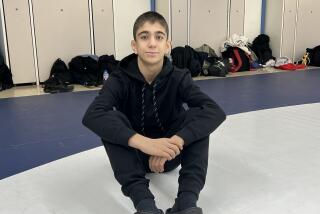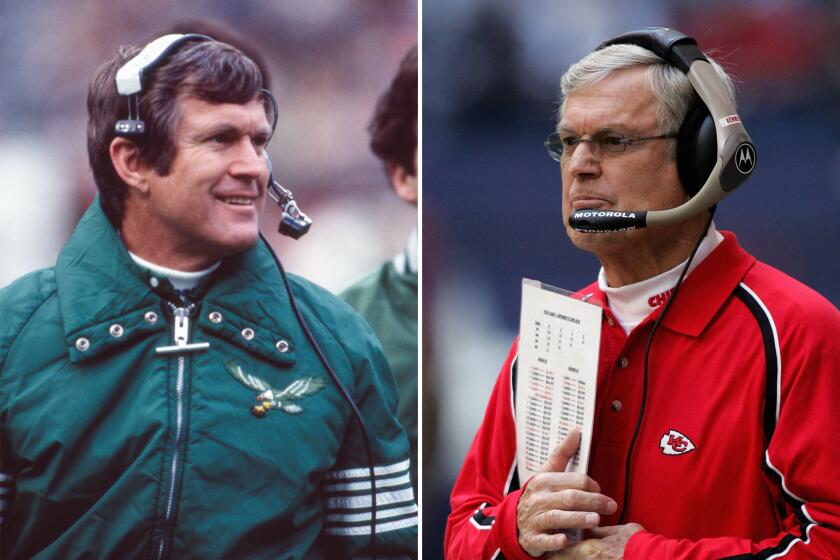Opponents of Hoover Wrestler Dye Haven’t Found Him to Be Lacking
- Share via
SAN DIEGO — For David Dye, the wrestler, balance is important to success.
For David Dye, the high school philosopher, balance is at the base of existence.
That theme comes up a lot, Dye says, when he goes hiking or takes off to a local lake to throw a line in the water.
“When I’m out there alone in the woods, it’s easy to think about how big the world is and how small you are in comparison,” Dye said. “Everything and each person has a role to play. You have to think of yourself as a whole person, because, really, you play a role in the balance of things. Everything balances because everyone is different.”
With a perspective like that, Dye does not worry that his left arm stops just above the elbow.
Dye figures there is a reason why his mother’s umbilical cord was wrapped around his arm, stunting the growth below that point. But he has never let that stop him.
Wrestling is an example. Dye, a 17-year-old senior at Hoover High School, has become one of the best 108-pound wrestlers in San Diego County. He is 23-4 this season and finished second at last Saturday’s San Diego Section 2-A meet.
Dye will be competing in Saturday’s Masters meet at El Camino High with an eye on a top four finish. Three of the likely top four seeds have beaten him and the other, El Camino’s Mike Grubbs, is ranked No. 1 in the state.
One of the four, Hugo Martinez of San Marcos, has beaten him twice this season, but the last was a 10-9 decision last Saturday in the 2-A final. Dye’s coach, Steve Stone, thinks he may be capable of moving up.
“His chances are pretty good of making it in the top four,” Stone said. “The guys above him are pretty good. And David’s not having an arm has nothing to do with his chances of beating them.”
It hasn’t had much to do with anything in Dye’s life.
“He has adapted so well that I have to remind myself, ‘Oh yeah. He just has one arm,’ ” said Morris Dye, David’s 31-year-old brother. “He adapted because he was born that way, and he couldn’t do much about it. His whole development is impressive. He never let it bother him.”
David Dye said that is not entirely true. He felt different at times, times when he felt he couldn’t do things, especially when he was 8 or 9.
“There were times when I’d be out fishing on a hot day, and I’d think, ‘I just wish I could trash this thing,” Dye said of his prosthesis. “I never told my parents because I didn’t want them to feel bad. It wasn’t their fault. It’s just one of those unknown things.”
Dye said the feelings went away when he started to play sports. He found that he could participate in several different areas.
The arm never caused a problem when he would take his bike out on the bicycle-motocross track. He’d just wear his prosthesis to help him steer and he’d get as much “air” as anyone else off the jumps, Dye said.
Dye could still swim on a team. It hasn’t stopped him from skiing, either. Stone says Dye has been bugging him all season to take the team on a trip.
When he was younger, Dye played second base. He never hit for power, but he was a good fielder. He’d wear a glove on his right hand and knock grounders down like a hockey goalie, then throw off the glove and make the play.
“I was good at turning the double play,” he said. “When I got to high school, a lot of guys wanted me to go out for the team, but I decided I wanted to get into wrestling.”
Dye was sitting in Stone’s sophomore biology class one day when he informed Stone he would be wrestling.
Dye had wrestled for only a few weeks in junior high, and Stone was not sure how he would do. But he gave him the same tryout he gave everyone else: “I put him on the mat. If he won, he’d be the guy who would wrestle at that weight.”
Dye won. He did not have as much success his first year as later, compiling a record of about .500. But Dye made the 100-pound weight requirement every week and wrestled in every meet.
Stone said the guys on the team treated Dye just like anyone else, and no one from other teams said anything disparaging. But Dye said he felt like some opponents thought lightly of him.
“A lot of people underestimated my ability,” he said. “ What is some guy with one arm going to do to us? They thought I couldn’t succeed in a sport where your arms are so important.”
That made Dye work even harder in the off-season between his sophomore and junior years.
He also figured out ways to strengthen the muscles in his left shoulder. He’d stick his left arm underneath a chair and lift it, using his right hand to balance the chair, or he’d put books in a backpack and lift that several times. His left shoulder looks as big as his right one now.
The combination of added strength and experience showed in his junior year. Dye was 27-7 and led Hoover with 17 pins.
Now, it’s easier for Dye to come up with the advantages of having just one full arm rather than the disadvantages.
“I can get it out of places where other guys can’t,” Dye said. “I can get it through smaller holes and slip it through different ways.
“(Some holds are) more solid because I can get it tighter. They try to bend it to get out, but there is nothing to bend. It’s like a club.
“I guess the only real problem is I can’t block my legs as well from the standing position. I can’t hold them off with my left arm.”
But that has not often been a problem. Dye sees it as just another challenge.
“And I like challenges because you can conquer them and come out with a rewarding experience,” he said. “I get a lot of self-pride from that. Some people have told me that I can’t do things. But I like to show people that the unthinkable is possible.”
More to Read
Go beyond the scoreboard
Get the latest on L.A.'s teams in the daily Sports Report newsletter.
You may occasionally receive promotional content from the Los Angeles Times.










